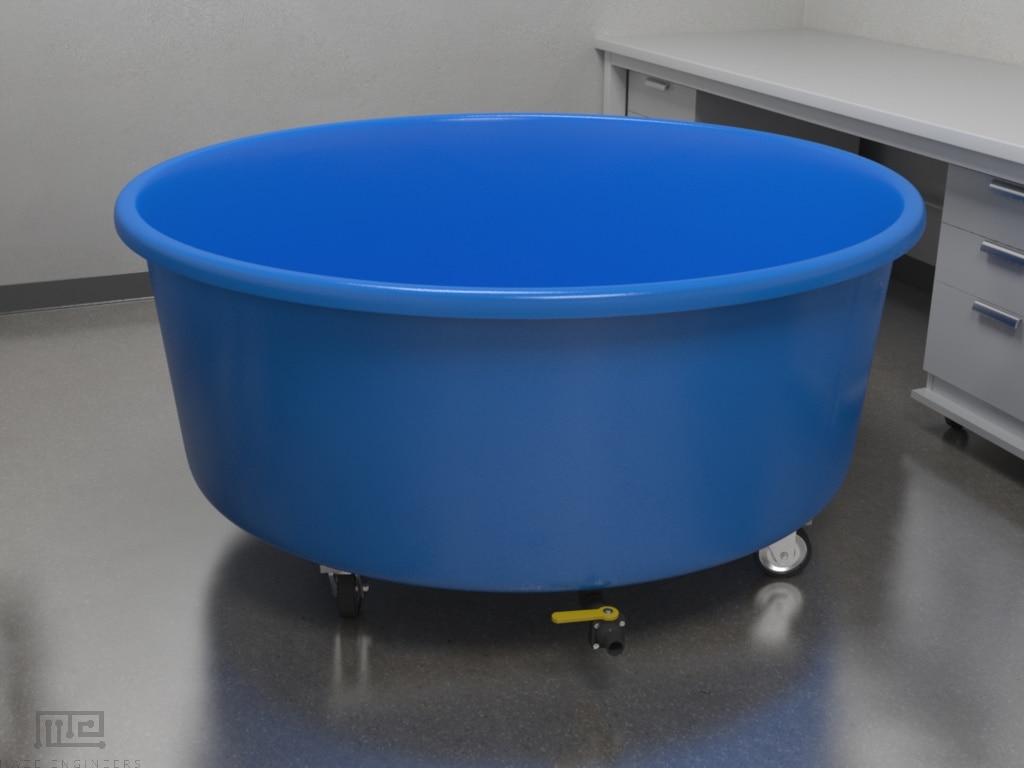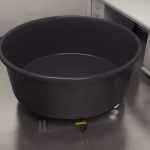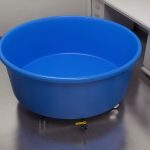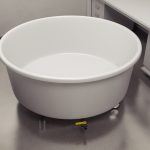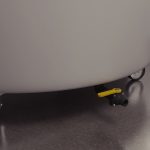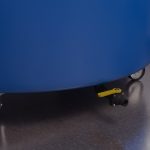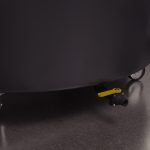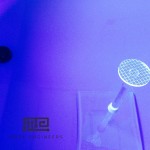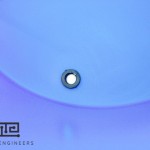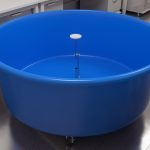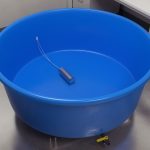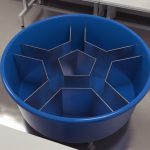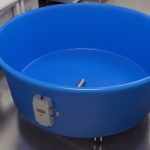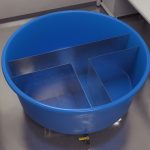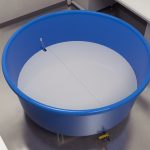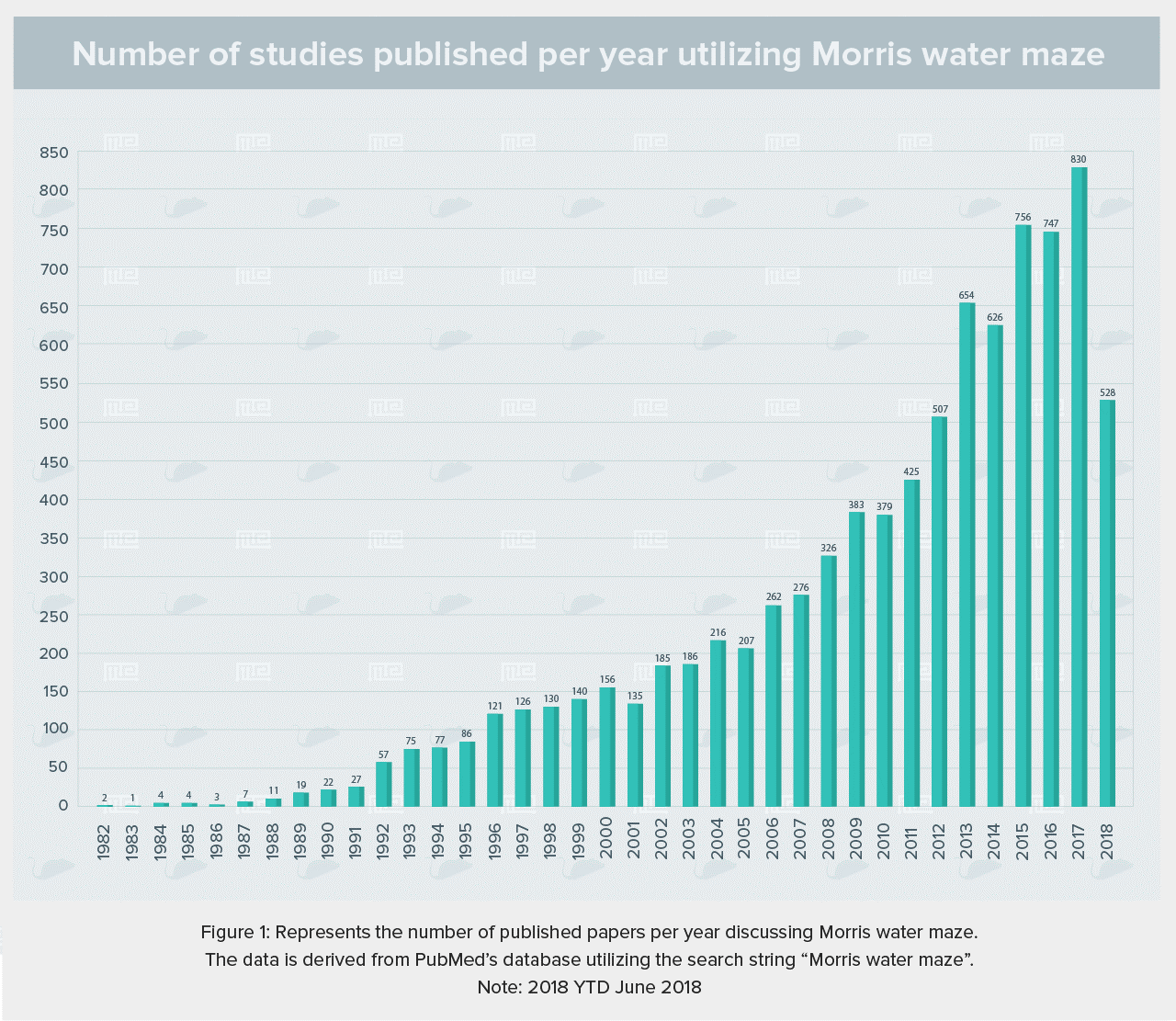Product Description
The Morris water maze (MWM) is a behavioral test used to assess spatial learning and memory in small animals such as rats and mice. The maze consists of a large circular pool filled with water, with a hidden adjustable platform placed at a fixed location beneath the surface. The pool is usually made of blue, black, or white plastic, and the water is made opaque with the addition of a white powder or paint. The animal is placed in the pool and is required to find the hidden platform in order to escape the water.
During the test, the animal’s movements are tracked, and different measures such as the time taken to find the platform, the distance travelled, and the swimming path can be used to assess its spatial learning and memory abilities. The test is typically conducted over a period of several days, with the animal’s performance improving over time as it learns the location of the platform. The Morris water maze test is a widely used and reliable method for assessing spatial learning and memory in rodents, and it has been used in a wide range of neuroscience research, including studies on aging, brain injury, and neurological disorders.
Maze Engineers offers the Morris Water Maze. Customizations are available upon request.
The hidden platform is included in your order.
Pricing
4 Ft (Mouse)
$ 1490
One maze + one platform- Polyethylene exterior
- Uncloggable drain placed on the side or underneath (steel frame required for drains underneath). Choice upon ordering
- 1 adjustable platform included
5ft (Intermediate)
$ 1690
Per Month- Polyethylene exterior
- Uncloggable drain placed on the side or underneath (steel frame required for drains underneath). Choice upon ordering
- 1 adjustable platform included
6 Ft (Rat)
$ 1890
One maze + one platform- Polyethylene exterior
- Uncloggable drain placed on the side or underneath (steel frame required for drains underneath). Choice upon ordering
- 1 adjustable platform included
Accessories
Frequently Asked Questions
What are the dimensions of the Morris Water Maze?
- Mouse Size Dimensions:
Diameter: 120cm
Height: 81cm
- Rat Size Dimensions:
Diameter: 180cm
Height: 76cm
How much water can the Morris Water Maze hold?
- For the mouse MWM model: 210 gallons
- For the rat MWM model: 450 gallons
Keep in mind the MWM does not need to be filled to the top for experimentation.
Documentation
The Morris Water Maze (MWM) is a water navigation task developed by Richard G. Morris in 1981 as a response to the Radial Arm Maze (RAM). The task was developed to show that local clues (auditory, visual or olfactory) were not necessary for spatial learning (Morris 1981). The maze utilizes the averseness of water in motivating the subject to learn and find the escape platform rapidly. The purpose of the MWM is the same as that of the RAM, that is, the assessment of spatial learning. However, the tasks are achieved under different environments and motivations.
The Morris Water Maze eliminates choice-point decisions as seen in the RAM and other mazes that were modeled on nature’s burrow and trail systems. Further, the MWM forces the animal to use its own spatial localization system to guide it to the goal location. The maze since its development has been a popular water navigation task in behavioral neuroscience to study spatial learning and memory. The task enables accurate assessment of spatial working, and other learning and memory aspects, making it an effective tool in measuring the effects of neurocognitive disorders, lesions, and age. The task can also be extended to studying the development of possible neural treatments.
The original design of the apparatus created by Morris (1981) included a 1.3 m diameter large pool of height 0.6 m, which was filled with water to a height of 0.4 m above the base. Two distinguishable escape platforms 0.4 m and 0.39 m in height were used to create a visible platform (painted black) and an invisible platform (painted silvery-white), respectively. The water was also made opaque by the addition of powder, paint, or milk to it, such that the invisible platform was concealed. The apparatus can easily be adapted and modified using simple inserts to create hybrid mazes such as the Water T-Maze, Water RAM, Water Y-Maze and Water Plus Maze.
History
Origin
In 1981, Morris R. developed the Morris Water Maze, a simple and inexpensive navigational task that required continuous decision-making by the subject to escape from the water. The task involved a large pool filled with water, into which the rats were immersed and forced to swim to find one of the two, visible and invisible, escape platforms. Due to the limitations in local olfactory, auditory and visual clues, the subject is forced to depend on its own spatial learning system to reach the goal. Morris used 4 groups of rats and tested them in a setup wherein they were presented with an escape platform that was above or just below the surface and in a fixed or varied location. The experiment following the initial test, investigated the performance of the rats when they were placed in a novel starting position.
Further papers published by Morris evaluated hippocampal-dependent learning over several years (Morris 1981, Morris 1982, Morris 1984, Morris 1986). The maze also gained popularity when it was used by Ian Whishaw’s group in Canada (Kolb et al., 1982, Kolb et al., 1983).
Developments
Since its conception and development by Richard Morris at the University of St. Andrews in Scotland, the Morris Water Maze became a viral behavioral assay for spatial learning and memory. The MWM allowed testing of different variables of behavioral investigations, including pharmacological assessment and cerebral function, making it a popular choice for research in the domain of neurodegenerative and neuropsychiatric disorders, compound testing, and lesion models.
Since the initial papers, the maze has been used to study various disease models, including endocrine abnormalities, strokes, Alzheimer’s disease, other neurodegenerative diseases, and their effects on learning and memory (Brandeis et al., 1989).
Hamm et al. used the Morris Water Maze to investigate the generality of cognitive deficits observed after traumatic brain injury (TBI). The participants were subjected to three tests; the Passive avoidance test and constant-start versions of the MWM that did not require hippocampal processing and the standard MWM task that relied on hippocampal processing. In their findings, they were able to observe that fluid percussion TBI did not impair performance in the passive avoidance test and the constant-start tasks of the MWM.
Recent developments
In their investigation, Kishi et al. were able to observe that exercise improved cognitive decline as determined by the Morris Water Maze performance. Cognitive decline is seen as one of the critical organ damage of hypertension and studies have indicated that the decrease in BDNF in hippocampus causes the cognitive decline. Kishi’s investigation tested stroke-prone spontaneously hypertensive rats and was able to conclude that caloric restriction, in addition, to exercise up-regulated BDNF in the hippocampus leading to synergetic protection against cognitive decline.
Hosseini and colleagues (2017) investigated the effects of vitamin C during neonatal and juvenile growth on the learning and memory abilities of rats. The rats treated with 10-500 mg/kg of vitamin C showed reduced latency and travel distance and an increase in time spent in the target quadrant in the MWM task.
Apparatus & Equipment
The apparatus consists of a large circular pool that has a diameter ranging from 120 cm to 180 cm and a height of anywhere between 55 to 95 cm, depending on the subject being used in the task. The pool is filled with clean, room-temperature water to a height that does not allow the subject to touch the floor of the pool or climb over the walls of the pool. It is ensured that the color of the pool is in contrast to the color of the subject to allow easy location of the subject.
The escape platforms are generally 8 cm in diameter and are matched to the color of the pool or water (in the case of using colored water). For trials that require the pool water to be made opaque, milk or non-toxic colorant is mixed with the water. Both intra-maze and extra-maze cues may be used to help orient the subject and assist them in remembering the location of the escape platform.
Automated scoring can be performed with the assistance of video and tracking software such as the Noldus Ethovision XT and ANY-Maze.
Protocol
The Morris Water Maze assesses spatial memory and learning by relying on fear motivation induced by water and the subject’s eagerness to escape it to avoid drowning. The environment of the MWM forces the subject to rapidly learn and locate the platforms to escape from the water. The task provides information on hippocampal-dependent learning, specifically spatial and long-term spatial memory. The task can be performed with or without intra-maze or extra-maze visual cues to create different levels of difficulty. The ability of the subject to perform the task decreases with impaired neurocognitive abilities as observed in neurodegenerative and neuropsychiatric disorders, age-related models and in lesion models.
Pre-Training for the Morris Water Maze
The pool is filled with clean water such that the platform is visible by 1 cm. Visual cues, if any, are set up in and around the maze. The subject is brought into the room and allowed at least 15 minutes to acclimate to the test area.
Subjects are trained in three consecutive trials. At first, the subject is placed on the platform in the pool for 20 seconds to familiarize it with its presence in the maze. The pool is virtually divided into four quadrants with four start points: north, south, east, and west. The subject is gently lowered into the pool from one of these start positions, facing the wall. At first, the subject might swim around the edge but will eventually search for the platform it was familiarized with earlier. The subject is given 60 seconds to find the escape platform. In case the subject fails to locate the platform within the set time it is gently guided towards the platform.
The process is repeated for 2 or 3 more trials with an inter-trial interval of 5-minutes and with a different start position for each trial. On completion of all the trials, the subject is removed from the pool, dried and placed under a heat lamp before returning it to its housing.
Morris Water Maze Acquisition Testing
Following pre-training, the pool is once again set up as before with the escape platform placed in the same position. For the acquisition trial, the water is colored. Each subject is evaluated in 12 trials, with every three trials dedicated to one of the four starting points.
The subject is gently placed in the pool facing the wall, from one of the start positions and allowed 60 seconds to find the hidden platform which is now placed 2 cm under the water level. On finding the platform, the subject is allowed 10 seconds to rest on it. In the event, the subject fails to find the platform it is gently guided towards it. The trials are repeated for each subject before moving on to the next trial until all twelve trials have been completed.
Morris Water Maze Spatial Probe Trial
The spatial probe trial is conducted after acquisition testing to ensure that the subject is aware of the location of the hidden platform. For this trial, the pool is set up as before except the hidden platform is now removed. The spatial probe trial is used to test the subject’s knowledge of the location of the platform which is demonstrated by the subject quickly swimming in the direction of the hidden platform. Each trial lasts at least 30 seconds.
The subject is gently placed in the pool facing the walls from one of the start positions and the number of times it crosses the platform location is recorded. On completion of the trial, the subject is removed, dried and returned to its home cage.
Morris Water Maze Working Memory testing
The working memory task also known as reversal testing is performed after the acquisition trial to ensure that the subject is aware of the location of the hidden platform. The apparatus is set up as in the acquisition trial, and the subject is released facing the wall from one of the start positions. The trial lasts for at least 30 seconds. When the subject finds the platform, it is allowed to rest on it for 10 seconds after which it is removed from the maze and held in its housing for a pre-set interval. After the interval, the position of the platform is changed, and the is once again released from the same start position. The time taken by the subject is recorded. Trials are repeated on a two-trial per day basis for at least four days.
Modifications
Since its introduction, the Morris Water Maze has seen many variations in protocol and varying pool sizes. The maze has shown great success in a variety of investigatory processes and applications, including the testing of transgenic mice (D’Hooge and De Deyn 2001).
An “on-demand” procedure was described by Buresová et al. in their 1985 paper which replaced rigid platforms with collapsible platforms. The modification prevented a chance finding of the platform by the subject. A computerized system tracked the location of the subject and raised the platform when the subject had remained in the target area for a pre-determined time. The modification was further improved upon by Spooner et al. This modification allowed a highly focused search strategy.
Markowska et al. suggested a variation to the probe test that provided a more sensitive measure of spatial memory and proved more useful for repeated trials. Their modification suggested using a variable interval probe test wherein the platform is made available to the subject during the trial after a set interval. In comparison to the no-platform probe test, the variable-interval probe test proved to be more useful. Steele and Morris suggested another protocol variation in their paper published in 1999. Their suggestion involved moving the escape platform to a new location on each testing day, thus preventing the animal from knowing the location of the platform during the first trial. Eventually, once the animal had located the platform, it learns and remembers the location in one trial. The varying inter-trial interval can also assist in studying spatial memory.
In their 2007 investigation, Clark et al. modified the standard water maze by including spatial beacons in each of the four quadrants of the MWM. This modification causes the subjects to abandon a strict spatial strategy in favor of using the beacons to guide them to the escape platforms.
Other simple modifications include combining the Morris Water Maze with other behavior assessment mazes such as the Radial Arm Maze and T-Maze. RAM inserts add spatial complexity and combine the measures of the dry Radial Arm Maze with the rapid learning and aversive aspect of the Morris Water Maze. Similar in application to the water-based Radial Arm Maze, are the Water Star Maze and Water Plus Maze. Another popular dry behavioral assay that is combined with the Morris Water Maze is the Y-Maze which is modeled on the T-Maze. The Water T-Maze and Water Y-Maze allow the evaluation of spatial memory and learning combined with the fear of drowning.
Further, varying the type of platform, such as using a floating platform (also see Adjustable platforms), can also provide another measure for spatial learning and memory. Another modification of the MWM is using a snowcone insert to create a geometric cue within the arena. The insert is often used in conjunction with a balloon positioned above or near the escape platform to evaluate cue-based navigation preference in rodents. The Morris Water Maze is a highly adaptable behavioral task and is easy to modify.
Data
In the Morris Water Maze task, the data is recorded for the latency to find the platform and the time spent in the target quadrant. With the help of tracking and video recording software, the path traversed by the subject can be mapped, and the velocity of the subject can also be observed.
The data obtained from the Morris Water Maze is generally visualized by graphing the time it takes the animal to locate the escape platform, which is referred to as the latency time. This time is obtained by observing the animals in the maze via a video and tracking software or by analyzing the recorded experiments with a stopwatch.
The latency to find the platform decreases with repeated trials. The latency time can be easily graphed and compared across the sham control and disease model or intervention groups. Using graphs to compare the latency time between different disease or treatment groups, allows for easy visualization of the effect on spatial memory and learning. Animals in the control groups should show a significant decrease in latency time as they rapidly learn the location of the escape platform. Animals as disease models of neurodegenerative disorders, for example, should show a much slower learning curve with higher latency times, even after several trials. Generally, animal cohorts of 20-30 animals are sufficient to obtain p-values of <0.05 using ANOVA, t-tests, or Bonferroni’s post hoc tests (Harrison et al., 2009).
Translational Data
The Morris Water Maze is a principal task in behavioral investigations and can also be extended to studies involving the understanding of cerebral functions and in the development of potential treatments.
Laczó et al. validated the translational potential of the Hidden Goal Task in Morris Water Maze in their investigation of disrupting potential scopolamine in rats and humans. Another similar study was conducted by Possin et al. to determine the validity of MWM in translational research for Alzheimer’s disease. Another study by Kishi et al. was able to observe that exercise with the addition of caloric restrictions was able to protect against cognitive decline in stroke-prone spontaneously hypertensive rats.
Virtual applications of the Morris Water Maze have also evolved with evolving technology. The Virtual Morris Water Maze enables testing of human subjects in a virtual reality version of the classic rodent maze. Astur and team were the first to use the Virtual MWM for evaluation of humans in 1998. Since then, investigations using human subjects in both analogous and homologous versions of the Morris Water Maze have occurred. The task can easily evaluate memory and learning performances of participants with different diseases, injuries, and neuropsychiatric disorders. Using a virtual environment is cost-effective and does not endanger the subjects. Since the maze environments are virtual, the possibility of creating environments to suit the needs of any investigation are endless.
Strengths and Limitations
The Morris Water Maze has high reliability across a wide range of tank configurations and testing procedures. Further, it serves as an effective method for measuring hippocampal-dependent spatial learning and memory. The navigational task in comparison to other mazes is less laborious and time-consuming, despite the requirement of pre-training.
The task is also able to differentiate between spatial and non-spatial learning by using visible and hidden platforms. The different possible variations in protocols such as Discrimination learning protocol, Cued learning protocol and Latent learning protocol (Vorhees and Williams 2006) allow for measuring the different specificity of spatial learning and memory. Since the task can employ various modifications, it can test the brain function of many brain areas, not only the hippocampus, and this allows the test to evaluate more general cognitive function in addition to specific learning and memory functions.
Despite the presence of an escape platform, this test places a significant amount of stress on the animals. Initially, when the animals are placed in the pool, they are forced into a stressful situation with no obvious escape route. The act of being immersed in water and forced to swim can induce stress that may alter the outcomes of each repeated trial. It is imperative to ensure that the water temperature is appropriate to minimize the stress experienced by the animals. Mazes can be purchased with temperature control to help reduce stress caused by the water being too cold or too hot. It is also essential to understand that there may be variations in performances of different strains and performances may be dependent on the age, gender and other aspects of the subjects used. The ability of the subject to swim is also a crucial factor in obtaining correct results.
Strengths & Limitations
- The Morris water Maze was developed by Richard G. Morris in 1981 to prove that the subjects are capable of spatial learning without the need for local cues (visual, olfactory or auditory)
- The task utilizes the averseness of the water in motivating the subject to learn and find the escape platform rapidly.
- The task eliminates the need for choice points as seen with behavioral assays such as the Radial Arm Maze, T-Maze, etc
- The task provides measures of hippocampal-dependent learning, specifically of spatial and long-term spatial memory.
- The pool water can be colored using milk or colorants such as paint to make it opaque.
- The pool should be filled with just enough water such that the animal’s paws do not touch the floor of the pool nor it can climb over the wall.
- The water temperature should be optimally maintained, and the subject should be gently dried and placed under a heat lamp before returning to its housing to minimize the stress on the subject.
- Subjects with cognitive deficits show a decline in performance in finding the platform and tend to have a slower learning curve with higher escape latency.
Sizing Chart
Mouse

Mouse Morris Water Maze Size (CM)
- Diameter: 120
- Height: 81
Intermediate

Intermediate Morris Water Maze Size (CM)
- Diameter: 155
- Height: 89
Request a quote
"*" indicates required fields

